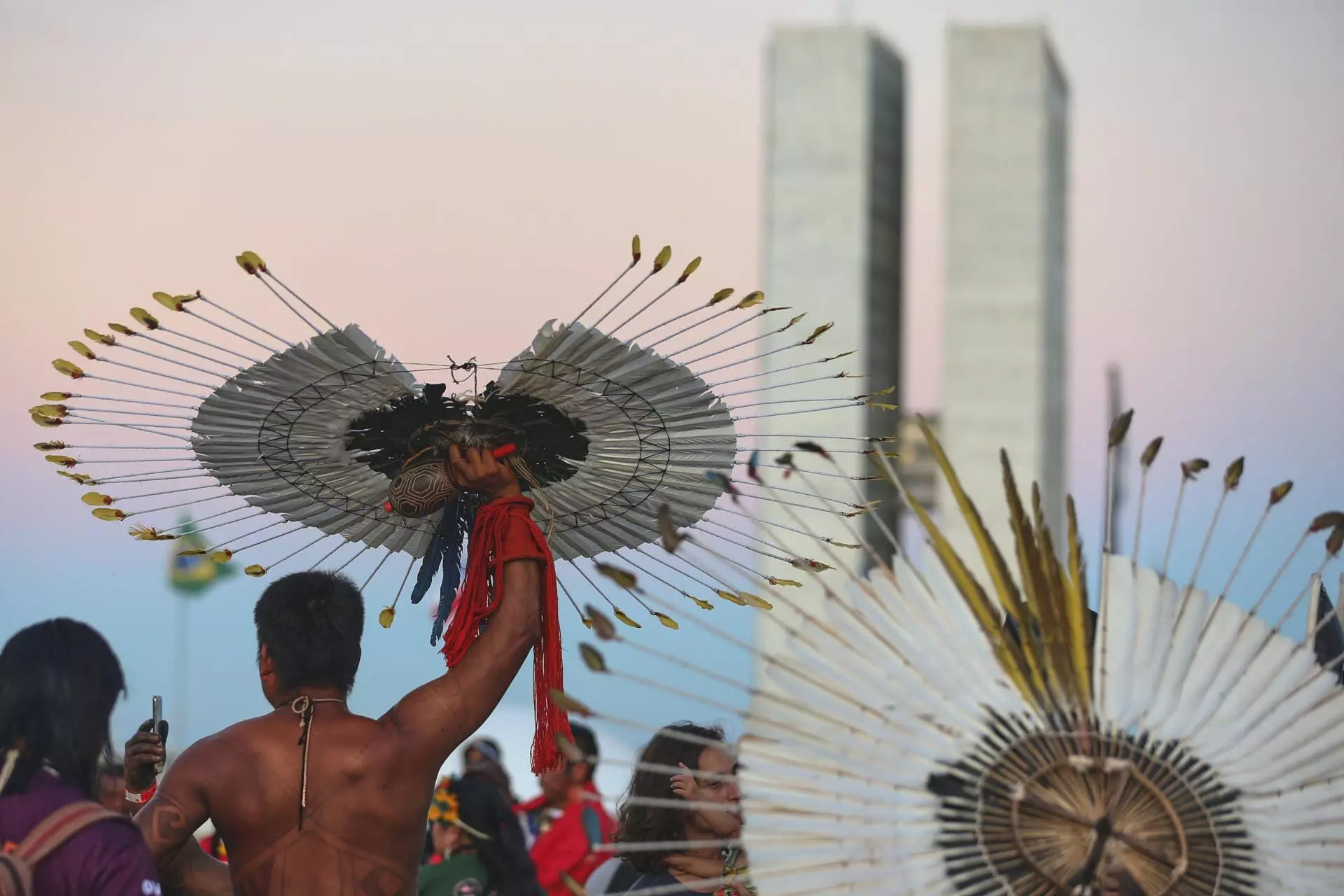With its marble floors and walls, leather-upholstered sofas, and portrait gallery of former presidents dating back to the country’s Imperial times, the Federal Supreme Court’s White Room is a place reserved for ceremonies, but it is also used by justices to meet with attorneys for parties to the processes being considered by Brazil’s highest court. Up until quite recently, Indigenous leaders were not likely to attend institutional meetings – rather than acts of protest – in these grandiose palaces created in Brasília for those exercising power.
The Supreme Court’s hearings on moves to impose a cut-off point on demarcation of Indigenous territory, which ended on September 21 when the remaining justices entered their final opinions, were the prompt for first peoples to embroil themselves in the rites and rituals of Brazil’s three branches of government, with the Indigenous movement now exerting significant political pressure. An Indigenous presence in the offices of the Supreme Court – which, up until a few years ago, were almost exclusively filled by corporate lawyers and powerful lobbyists – is no longer a rarity and has become normal.
During a session break on September 13, Rosa Weber, the chief justice of the Federal Supreme Court, welcomed a delegation of thirty Indigenous women from Brazil and abroad. They were taking part in the third edition of the Indigenous Women’s March on Brasília, organized by the National Alliance of Indigenous Warrior Women of the Ancestors (ANMIGA). The next day, on September 14, another group of Indigenous leaders – Angela Kaingang, Isabel Tukano e Antonia Xokleng – took advantage of their visit to Brasília to speak with two judges working under Justice Dias Toffoli. On August 29, Sonia Guajajara, the head of the Ministry of Indigenous Peoples, visited the offices of Supreme Court Justice Cristiano Zanin, along with the ministry’s executive secretary. On September 5, it was their turn to visit Justice Dias Toffoli.
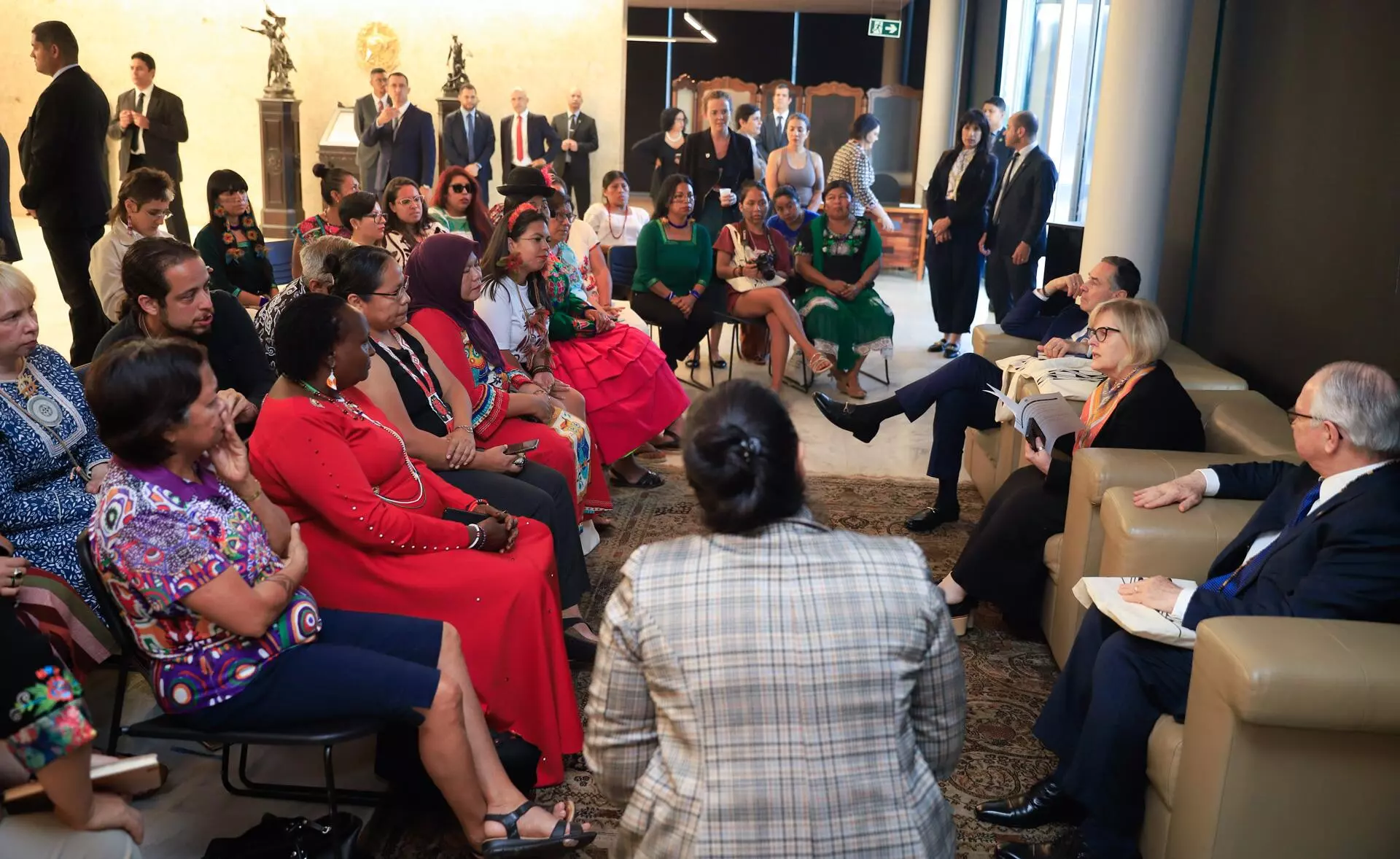
The Supreme Court’s Chief Justice, Rosa Weber, and Justices Luís Roberto Barroso and Edson Fachin welcome Indigenous women during a session break. Photo: Fellipe Sampaio /SCO/STF
Indigenous leaders’ “tour” of the Brazilian Judiciary has been successful, in the constant company of attorneys – most of whom are Indigenous – and presenting technical and grounded arguments against limiting demarcation to a historic cut-off point. On September 20 and 21, the Supreme Court resumed the last phase of “the trial of the century.” It was so called by the Indigenous community because its outcome would be essential for original peoples to continue to have full access to their territory, as mandated by the Constitution, thus defining their future.
The legal argument behind the historic cut-off point was finally defeated in the Supreme Court by a nine to two decision. According to this theory, Indigenous people would only be entitled to their territories if they had occupied them by the date of the Constitution’s enactment in 1988. This fails to consider the historical persecution of original peoples, exterminations, and the violent removal process many were subjected to, starting with the arrival of European invaders and gaining scale during the business-military dictatorship (1964-1985).
“Today, there is a network of Indigenous attorneys who think up and coordinate strategies for action, and it grew much stronger during the last administration [of Jair Bolsonaro], when Indigenous people had to turn to the courts because of a ruinous executive branch,” notes attorney Carolina Santana, who works for the Human Rights Observatory of Isolated Indigenous Peoples and who wrote a doctoral thesis on the historic cut-off point. The work of Indigenous attorneys was striking and decisive from the start of the Bolsonaro administration. In August 2020, the movement filed an action against the violation of a fundamental constitutional right with the Supreme Court (ADPF 709), demanding that the Brazilian government comply with the Constitution and protect Indigenous communities to stop the pandemic from advancing into their territories. Through the action, the movement also asked that non-Indigenous persons be removed from the Yanomami, Karipuna, Uru-Eu-Wau-Wau, Kayapo, Arariboia, Mundurucu, and Trincheira Bacaja Indigenous Territories.
A meeting with the chief justice
Accompanied by her colleagues Edson Fachin and Luís Roberto Barroso, the Supreme Court’s chief justice took fifteen minutes to hear what Indigenous women expect of Brazil’s highest court. At the march, the theme of which was “Biome Women in Defense of Biodiversity through Ancestral Roots,” the Indigenous women mostly protested against the historic cut-off point. Cristina Coc, a Maya Indigenous woman dedicated to environmental conservation and Indigenous rights in southern Belize, Central America, talked to the justices about decisions rendered by the Caribbean Court of Justice. In 2015, it upheld a series of lower court rulings guaranteeing self-determination for Indigenous Caribbeans. Cristina lauded the prohibition on mining on Indigenous lands contained in the Brazilian Constitution.
Meiliana Yumi, of Indonesia, then made brief comments – in her native language, translated into English by an interpreter and into Portuguese by delegation members – on the impact mining has had on original peoples on the island of Sumatra. Indonesia’s government allows mining on Indigenous lands, to devastating effect, according to Meiliana, especially for women, who are victims of sexually transmitted infections, trafficking, and prostitution.
Lucimara Patté gave Fachin, the Supreme Court’s rapporteur on the historic cut-off point case, a necklace her father made in the Morro dos Cavalos Indigenous Territory. She said it was to thank the justice for his ruling, making it a more remote possibility that a historic cut-off point well be set to demarcate Indigenous territories. The necklace she gave Fachin is a protective amulet. The justices were also given a report on violations against Indigenous women by anthropologist and activist Braulina Baniwa.
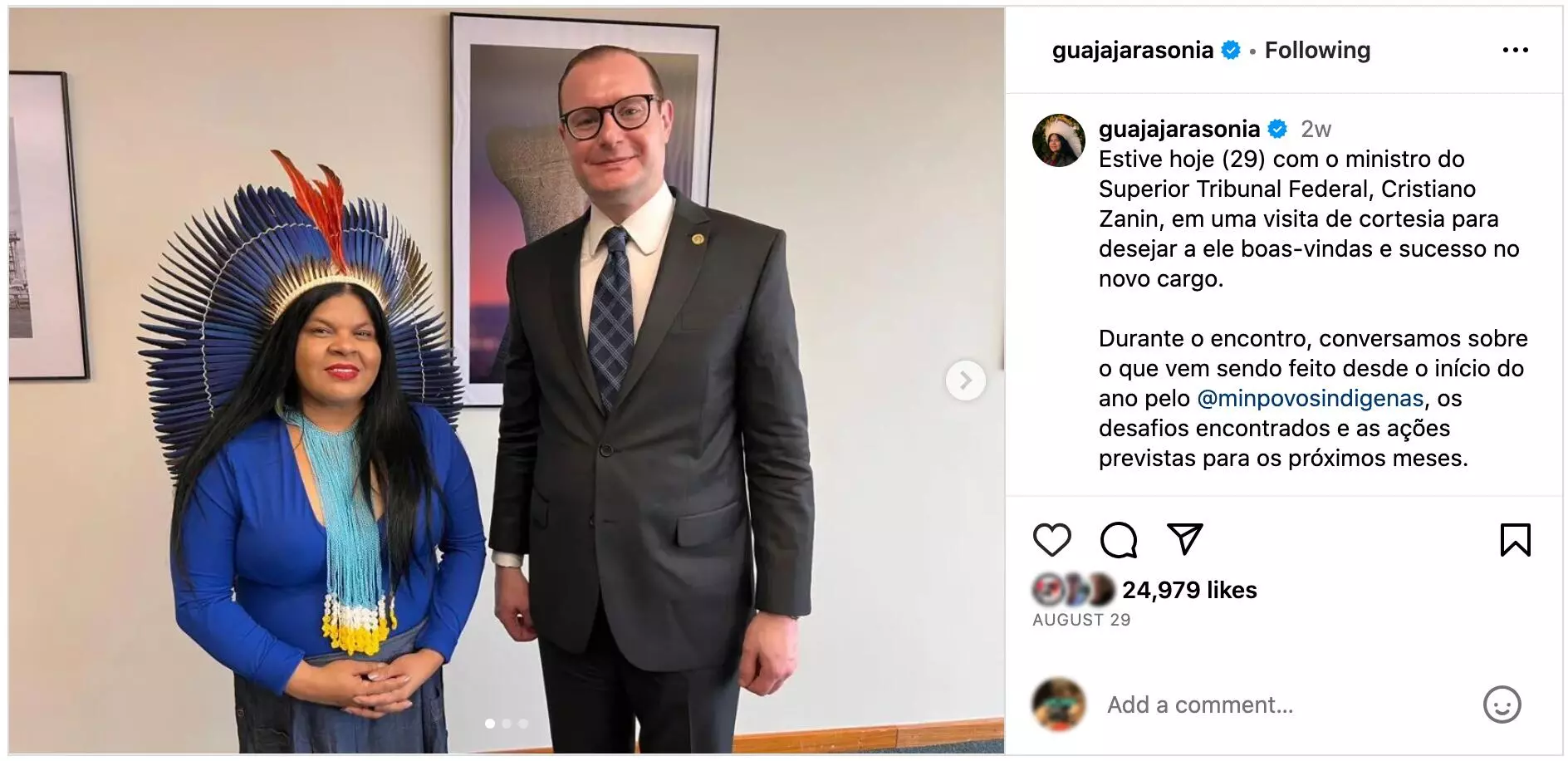
The leader of the Ministry of Indigenous Peoples, Sonia Guajajara, visited Justice Zanin’s office right before hearings resumed. Photo: Screen Print
Ruling by ruling
The “trial of the century” started with a dispute involving the Xokleng people of Santa Catarina and the state government. The Sassafrás State Biological Reserve overlaps the Ibirama-Laklãnõ Indigenous Territory, which is occupied by the Xokleng as well as by Kaingangs and Guaranis, in lesser numbers. The Santa Catarina state government went to court to force Brazil’s Indigenous affairs agency, FUNAI, to remove Indigenous people from preservation areas, with the case moving to the Federal Supreme Court. Rafael Modesto, an attorney for the Xokleng who is with the Indigenist Missionary Council (Cimi), says that ever since then he has tried to meet with all of the court’s justices – he was the one accompanying Angela Kaingang, Isabel Tukano, and Antonia Xokleng when they visited Toffoli.
Modesto says that the idea was to bring in Indigenous leaders to personally explain their reality and the implications of the ruling to the justices. “It was very important that the justices have heard Indigenous people. We [attorneys] were there more to discuss technical matters,” he says.
According to Modesto, representatives from Cimi, the National Conference of Bishops of Brazil and the Indigenous movement met with all of the court’s sitting justices — except for Moraes, who has a reputation in Brasília for being more reserved. On each occasion, Modesto says the reception from authorities was “quite positive” — even from justices who had opposing opinions, like André Mendonça and Kassio Nunes Marques. Both of the Bolsonaro appointees to the high court have ruled in favor of the historic cut-off point.
In talks with the judges working under Justice Toffoli – who has yet to render an opinion on the historic cut-off point – Angela Kaingang, Isabel Tukano, and Antonia Xokleng spent over an hour laying out a list of reasons why the historic cut-off point is unconstitutional. They also made clear their concerns about prior indemnification as a condition for new demarcations, a new angle raised in the ruling handed down by Justice Alexandre de Moraes. Finally, they advocated for exclusive usufruct by Indigenous people of traditionally occupied territories, as already set forth the Constitution.
When the justice understands…
For Indigenous people, one of the trial hearings, held on August 31, was a key moment. Nobody knew how recent appointee Justice Cristiano Zanin would rule. Nevertheless, he not only deviated from the historic cut-off argument, but also from the “prior indemnification” proposal contained in the ruling issued by Alexandre de Moraes — which in practice creates another complex step in the already lengthy process of demarcating Indigenous territories. If the justices are in favor of both of Zanin’s positions, the ruling will be a historical win for the Indigenous movement.
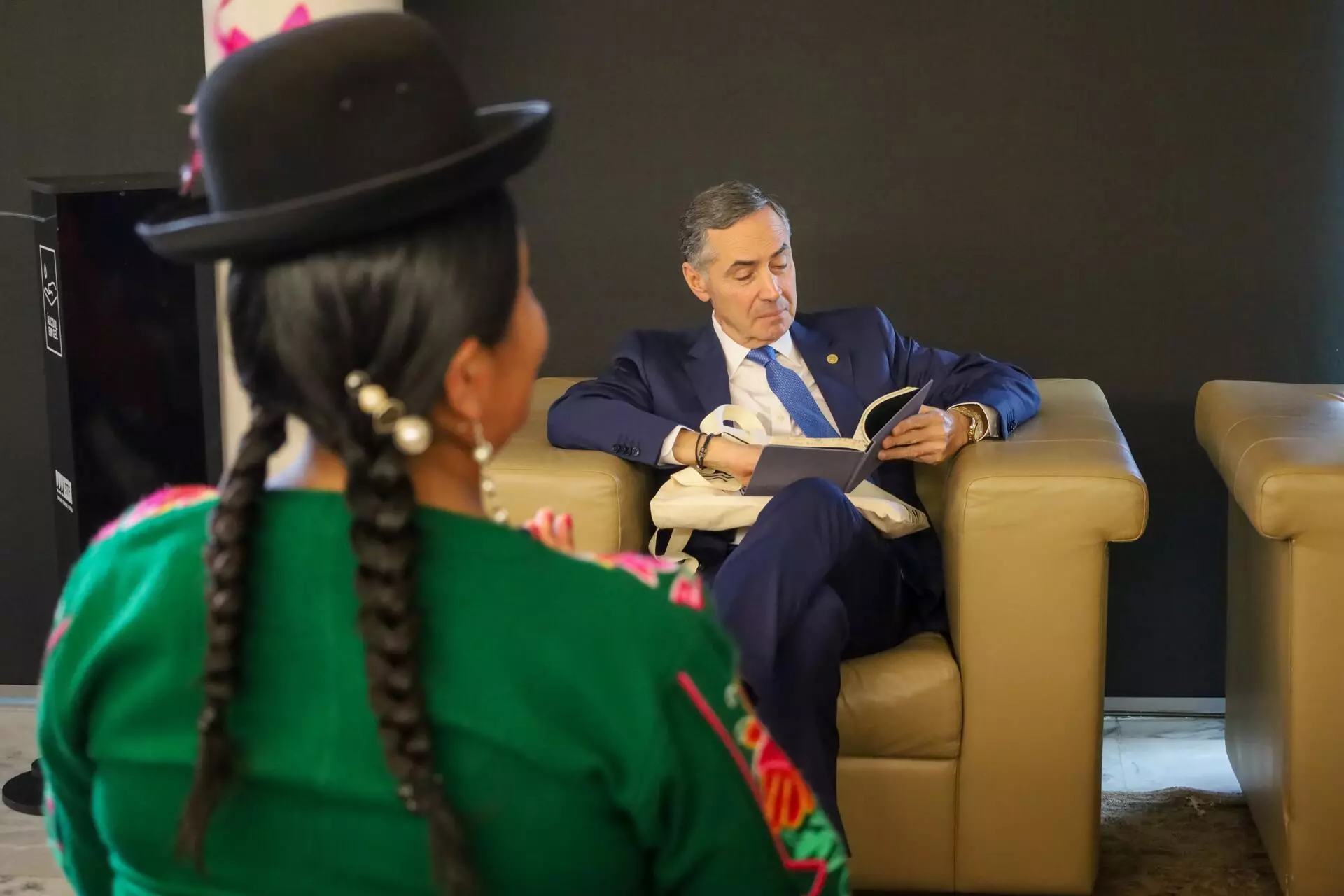
Justice Luís Roberto Barroso reads a book he received during a meeting with Indigenous women from Brazil, Indonesia and the Caribbean. Photo: Natalia Ramírez/Indigenous Peoples Rights International
“We brought our argument to Justice Zanin, and he seems to have thoroughly understood it,” says attorney Rafael Modesto. In his ruling, Zanin argues that good-faith squatters could in some cases be indemnified by the federal or state government, depending on the circumstance, but this would not interrupt the demarcation process. Modesto sees the ruling as “completely satisfactory” — an assessment shared by the minister of Indigenous Peoples, Sonia Guajajara, who made a point of posting pictures from the visit to Zanin’s office on her social media. The Indigenous People’s minister says that Zanin’s proposal “does not prevent the continuity and opening of new demarcation processes.”
Sonia Guajajara’s articulation against the historic cut-off point has also been intense. She recently met with Rosa Weber and, according to aides, she is seeking “constant dialog” with other authorities to “expose the importance” of the Indigenous agenda and the “threat” posed by the historic cut-off point — and by PL 2.903, a bill being considered in the Senate.
Occupy spaces
Dozens of Indigenous leaders, including a large contingent of Xokleng people, have attended every recent session of the Supreme Court’s plenary hearings. Cacique Raoni Metuktire, the biggest name in Brazil’s Indigenous movement, attended sessions in June and August of this year, staying from beginning to end, even though he is over 90 years old. Those unable to make it into the courthouse kept tabs on the rulings from the outside, on a big screen.
“It’s of the utmost importance to stress that this is the trial of the century. Indigenous peoples are awaiting this ruling to resume demarcations of Indigenous lands,” summed up Dinamam Tuxá, one of the coordinators of the Alliance of Indigenous Peoples of Brazil (APIB). The Indigenous people are in a hurry. “We have a very good expectation that there will be no more trial stoppages or requests to take the case under advisement,” said Kleber Karipuna, APIB’s executive coordinator, at the hearing held late August.
Rafael Modesto sees popular mobilization along with institutional articulation as fundamental to the ruling on the historic cut-off point — as well as to the debate on other matters of interest to the original peoples. He feels that 2015 was a crucial year for strengthening this strategy. It was then that the Federal Supreme Court, in less than six months, overturned directives demarcating three Indigenous territories. These setbacks demonstrated the need for a joint strategy between the streets and administrative channels.
Pride and prejudice
Although the ruling on the historic cut-off point is a testament to the strength of the Indigenous movement, racism against original peoples is far from being a phenomenon of the past and can still be found at the highest echelons of power.
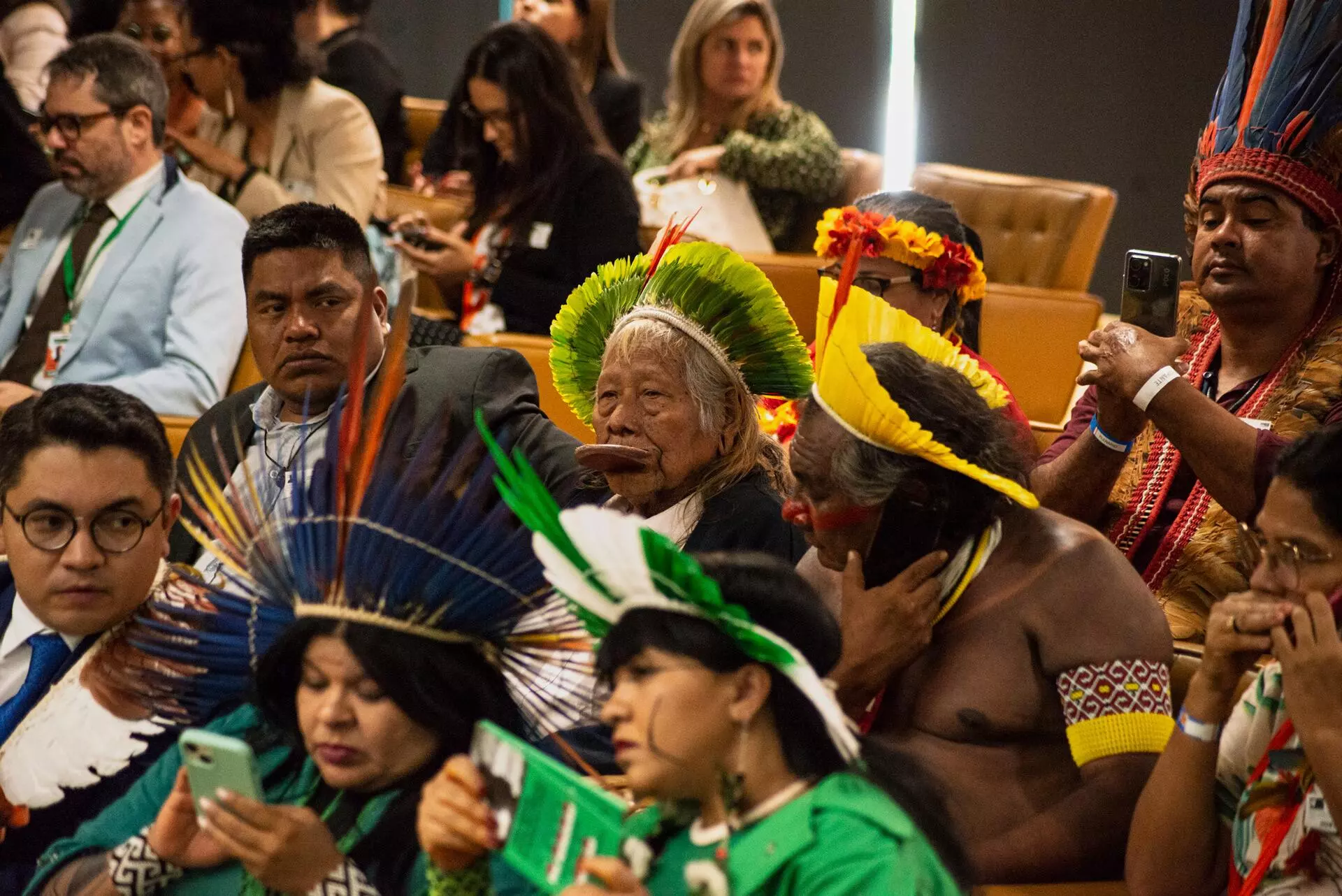
Despite his advanced age, Cacique Raoni Metuktire attended every session of the Supreme Court hearings held this year on the historic cut-off point. Photo: Matheus Alves/SUMAÚMA
Attendance by Raoni and dozens of other Indigenous leaders at the plenary sessions did nothing to shame Justice Gilmar Mendes, who at the start of the hearing interrupted Mendonça’s opinion with a long speech filled with prejudice against Indigenous peoples. He said that the Indigenous peoples of the Raposa Serra do Sol Indigenous Territory, in Roraima, started “collecting trash in Boa Vista” after invaders who were planting rice in the region were removed. Mendes also advocated for legalizing mining on demarcated lands and also accused Cacique Babau, a Tupinambá leader in Bahia, of not being Indigenous.
The justice’s speech left everyone in attendance uneasy, but it was particularly painful for Alcebias Constantino Sapará, the vice coordinator of the Coordination of Indigenous Organizations of the Brazilian Amazon (COAIB). “I’m from the Raposa Serra do Sol Indigenous Territory, which is why this speech really bothered me. I know my people’s reality. He said that my relatives went to the dump, that after the ‘rice farmers’ left everyone was starving to death. None of this is happening,” he said critically. “Why doesn’t he go there to see our reality? Our leaders will give him a warm welcome.”
Alcebias says that he is waiting for a retraction from the Supreme Court justice. In the meantime, the invitation for him to visit Indigenous territory and see the “reality” is something that still seems unlikely for those living inside marble palaces.
Fact check: Plínio Lopes
Spell check (Portuguese): Valquiria Della Pozza
Translation into Spanish: Meritxell Almarza
English translation: Sarah J. Johnson
Photography editing: Lela Beltrão
Page setup: Érica Saboya
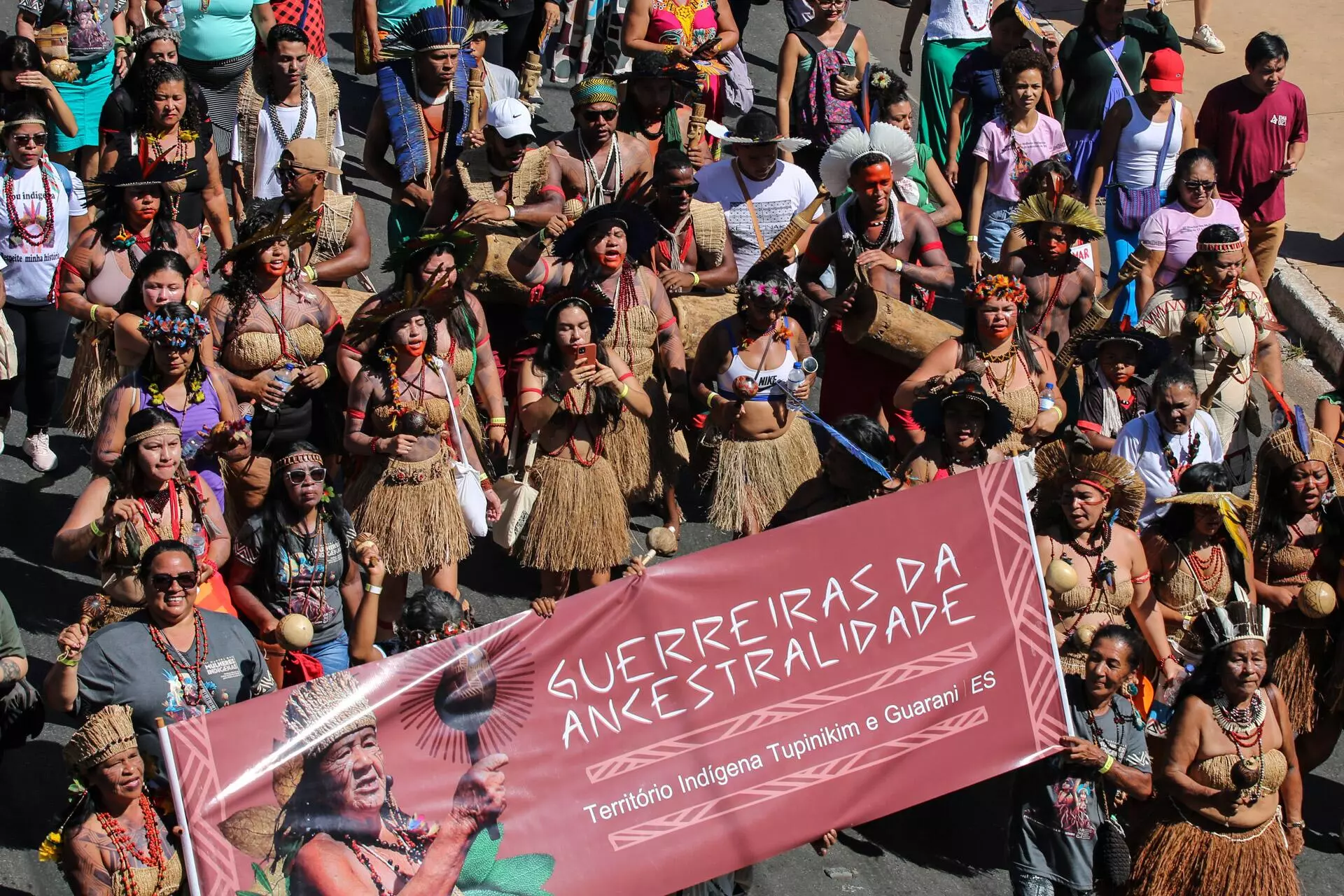
Indigenous women are taking a leading role in the fight against the historic cut-off point, as evidenced by the III March, the theme of which was ‘Biome Women in Defense of Biodiversity Through the Ancestral Roots.’ Photo: Scarlett Rocha/SUMAÚMA




